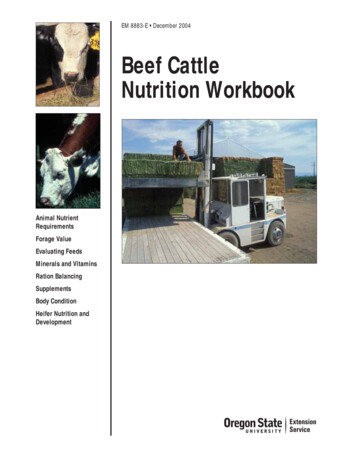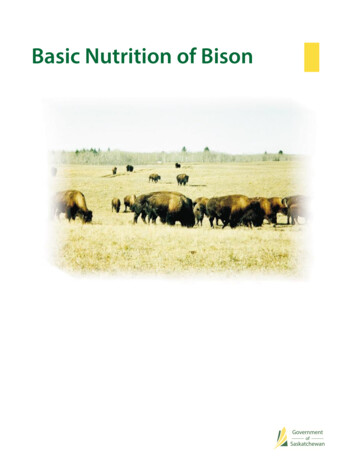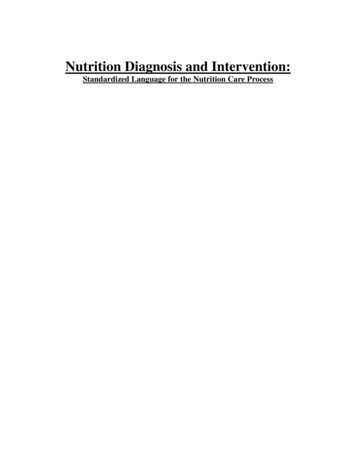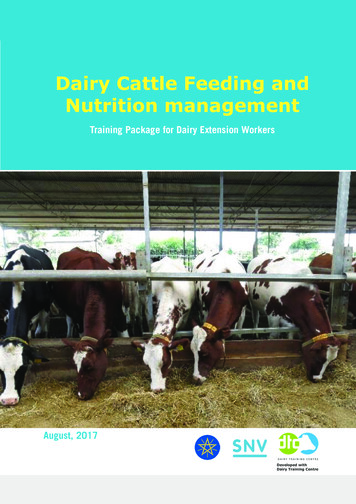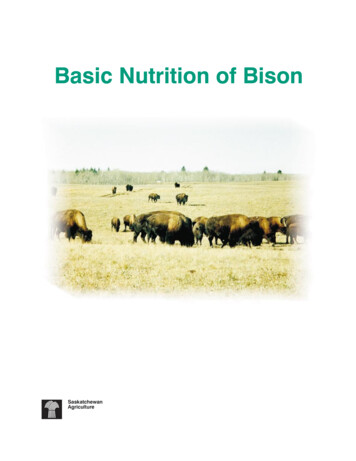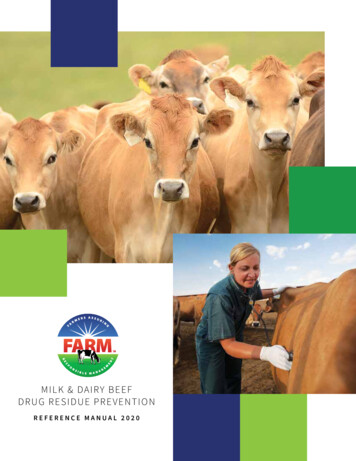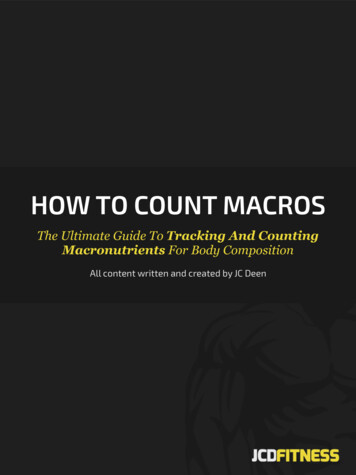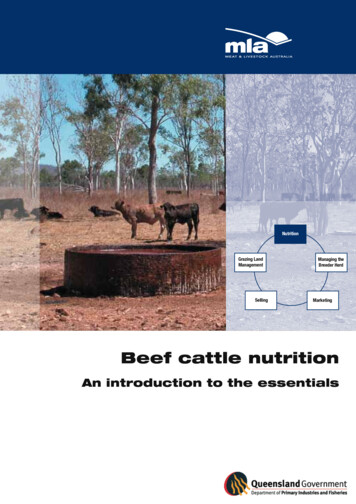
Transcription
NutritionGrazing LandManagementSellingManaging theBreeder HerdMarketingBeef cattle nutritionAn introduction to the essentials
Published by Meat & Livestock Australia LimitedRevised March 2015 Meat & Livestock Australia 2006ABN 39 081 678 364ISBN 1 74036 9289Care is taken to ensure the accuracy of the information contained in this publication. However MLA cannot accept responsibilityfor the accuracy or completeness of the information or opinions contained in the publication. You should make your ownenquiries before making decisions concerning your interests.MLA accepts no liability for any losses incurred if you rely solely on this publication.Reproduction in whole or part of this publication is prohibited without prior consent of and acknowledgement of Meat and Livestock Australia.
Beef cattle nutritionContentsA Quick Quiz to start you thinking . iiiDo I need to read this book? . ivBasic digestive anatomy and function .1Rumen and reticulum .2Ideal rumen environment . 3Omasum . 3Abomasum. 3Small intestine . 4Large intestine . 4What are nutrients? .5Water. 6Guide to use of saline water . 7Energy . 7Partition of feed energy. 8Which has the most energy? . 8Protein. 12Protein digestion and absorption. 12The basic process of protein in digestion and absorbtion . 12Undegraded dietary protein (UDP) or bypass protein . 14Intake of feed . 16Primary limiting nutrient . 17What does pasture cost? .18Pasture – the cheapest source of cattle feed . 19Measures of pasture quantity and quality. 20Principles of pasture growth (quantity) and its quality . 21Land type . 21Pasture type and species . 22Four phases of pasture growth and development . 23Temperate and tropical pastures . 24Legumes and grasses. 243Ps . 24Indicators of pasture quality . 24How does stocking rate influence liveweight numbers? . 24Carrying capacity (CC) . 26Principles of choosing a grazing system . 28Notes on some grazing systems . 28 Copyright MLA 2006Beef cattle nutrition
Some of the more common grazing systems . 29Determining livestock numbers using adult equivalents . 29The limitations of AEs . 30Relative adult equivalents . 31Developing a grazing management plan.32Principles of grazing management . 32Grazing pressure (GP) . 33Mineral nutrition of cattle .35Phosphorus. 36Other nutritional issues.41Supplementation. 41Primary limiting nutrient . 41Compensatary growth . 42Rumen modifiers . 43Hormonal growth promotants (HGPs) . 44Example of a break-even analysis . 45Answers to Quick Quiz .46Need more information?.464Beef cattle nutrition Copyright MLA 2006
A Quick Quiz to start you thinkingDo I understand the basic principles of my nutrition program or are there things I could bedoing better? – a quick self assessment guide.1. The EDGE network is:a. A Stephen Steilberg thriller set in theFrench Alps.b. A group of cut throat razor enthusiastswho meet every year in Yeppoon.c. An acronym for a weight watchersgroup in Eidsvold – Even Dad Gave-upEating.d. A set of highly developed educationalpackages produced by MLA to helpbeef producers manage their businessoperation.2. Adding 1 gram of Urea to asupplement is equivalent to includingapproximately how many grams ofcrude protein to the ration:a.b.c.d.1 g.2.87 g.6.25 g.100 g.3. Which statement on microbial protein(the protein contained in bugs in therumen) is true:a. It supplies all the protein requirementsof a beast at all stages of production.b. It is absorbed in the true stomach of aruminant.c. It can not routinely supply all theprotein requirements of young calvesand breeder cows producing lots ofmilk.d. All of the above. Copyright MLA 20064. Which statement on phosphorussupplementation in northern Australiais false:a. Can improve liveweight gains ingrowing animals by up to 40 kg overthe wet season.b. Provides no improvement to liveweightgains over the dry season.c. Should be included in both dry andwet season supplements.d. Should always be included withgrain supplements as grain is low inphosphorus.5. Which statement is true:a. Tropical grasses have higher proteinlevels than temperate grasses.b. Tropical grasses are more digestiblethan temperate grasses.c. Tropical grasses require less soilnitrogen to grow than temperategrasses.d. Tropical grasses have a lowermagnesium content than temperategrasses.6. A 400 kg breeder cow that is producing8 litres of milk a day will require:a. The same amount of feed as a dry cowthat is maintaining weight.b. About one and a half times as muchfeed as a dry cow maintaining weight.c. About twice as much feed as a drycow that is maintaining weight.d. None of the above.Beef cattle nutritioniii
Do I need to read this book?One of the key activities of Meat and Livestock Australia (MLA) is toensure that beef producers are able to access and implement the latestresearch results and management recommendations for their enterprise.A basic understanding of ‘why’ and ‘how’ things happen is fundamental toadoption of any new technology.Leading researchers and extension officers in the various fields havedeveloped a series of educational workshops and comprehensive trainingmanuals, combined into a package called the EDGEnetwork. Much of theinformation contained in this booklet is extracted from The Nutrition EDGEmanual. It was specifically designed to assist producers to understandthe feed requirements of their livestock and to assist in development ofsupplementation strategies and ration formulation. It utilises basic nutritionprinciples and provides feed values for most of the commonly used feedstuffs encountered in rearing and growing beef cattle.It is the hope of MLA that producers who read this booklet will be betterinformed on the nutrient values of their pastures and be able to place adollar value on all the nutritional inputs required to meet their productiontargets. Furthermore, it is envisaged that it may encourage enthusiasticoperators who are keen to understand their business, to participate in a3-day Nutrition EDGE workshop. In a workshop environment, they willexplore and develop in greater depth, the basic principles introduced inthis booklet – the ultimate aim being to cost effectively feed and nourishtheir stock.ivBeef cattle nutrition Copyright MLA 2006
Basic digestive anatomy andfunctionAn understanding of the components and development of the digestivetract of cattle is important to understand cattle nutrient requirements andhow best to meet these.The majority of feed available to grazing animals is high in fibre. That is, thefeed contains large structural carbohydrates such as cellulose. Very fewanimals, and no mammals, have the enzyme systems necessary to digestfibre. However, certain microorganisms do have these enzymes.Ruminants are mammals that have evolved a specialist digestive systemthat enables them to utilise high-fibre diets such as grass. This digestivesystem makes use of fibre-digesting microorganisms. The majority of thesemicroorganisms live in the rumen and reticulum.Ruminants such as cattle and sheep are more efficient at converting grassinto meat (and wool) than simple stomach animals such as pigs. However,the ruminant digestive system is less efficient than the monogastricdigestive system at digesting high-energy diets, such as grain.Key points to note are: ruminants, such as cattle and sheep, have a complex digestive system.They have four stomachs and each does a different job (this is differentto monogastrics such as pigs and people that only have one stomach) the rumen changes as the animal grows balancing the nutrient requirements of both the rumen microorganismsand the animal is essential for good animal performance.Chewed food is transferred from the mouth to the rumen via theoesophagus. The oesophagus also conveys partially digested food (thecud) from the rumen to the mouth where it is further ground by chewing tomake it easier to digest. Copyright MLA 2006Beef cattle nutrition1
Rumen and reticulumRUMEN– Hollow muscular organ– Fingerlike projections– Site of absorptionOMASUM– Layered muscular organ– Removes excess water– Reduces particle sizeRETICULUM– Acts as sieve– Starts rumination– Retains large itemsABOMASUM– Glandular stomach– Acid and enzymedigestionThe rumen and reticulum act as a fermentation vat in which plant materialis broken down by millions of microorganisms.Between 60 and 70% of all digestion happens in the rumen. In summary,fibre is broken down and much of the protein ingested is converted tomicrobial protein. The rumen is also the site where carbohydrates arefermented to volatile fatty acids, which are then absorbed across therumen wall where they enter the blood stream and are converted in thebody to glucose and fat.At birth, a calf’s rumen is very small and doesn’t function. It develops andgrows quickly so that, by the time the calf is about eight weeks old, itsrumen is able to break down plant material.Microorganisms require rumen conditions to remain within a specific,limited range to function properly. The rumen fluid should be slightly acid(pH 6.5 to 7.0) and there should be a plentiful supply of ammonia andcarbohydrates to feed the microbial population. The microbes also requirean anaerobic (oxygen free) environment.Obviously, the type of feed available to the animal will influence thesefactors. For example, mature dry grasses will be low in protein andcarbohydrate, thereby limiting microbial growth. Conversably highgrain diets can lead to high acidity (low pH) that is toxic to many rumenmicroorganisms and will also compromise microbial growth and digestion.2Beef cattle nutrition Copyright MLA 2006
Ideal rumen environment Warm37.5–42 C MoistLarge quantity of water AnaerobicFree of oxygen pH6.5–7, i.e. slightly acidic Active2–3 contractions/minute LARGE FERMENTATION VATThe inter-dependency between the rumen microbes and the ruminantanimal is a good example of a symbiotic relationship. The grazing animalprovides the home (the rumen) and harvests the forage; the microbesdigest the forage to supply the nutrients for their own growth andreproduction. Nutrients that are not utilised by the microbes, and themicrobes themselves, supply the all the nutrients for the animal’s growthand reproduction.OmasumThe detailed function of the omasum is not well understood. It appearsto be involved in reducing the amount of water passing out of the rumenwith the partially digested plant material, in further grinding the food and insqueezing the digesta through to the abomasum.AbomasumThe abomasum is the true, gastric stomach of the animal, similar infunction to the stomach of monogastric animals (e.g. pigs) and people.Protein and some fats are digested in the abomasum with the aid ofhydrochloric acid and enzymes Copyright MLA 2006Beef cattle nutrition3
Small intestineThe small intestine is the main site for the digestion and absorption ofamino acids, fats and the limited amount of glucose that may be available.The bile and pancreatic ducts open into the small intestine, deliveringenzymes, solvents, buffers and other agents (such as sodium bicarbonate)to aid the process of digestion.Large intestineThe large intestine consists of the caecum, colon, rectum and anus. Somebreakdown of feed by microorganisms takes place in the large intestinebut the products are generally not absorbed. The primary role of the largeintestine in ruminants is to absorb water and to collect waste material fromdigestion prior to defecation.4Beef cattle nutrition Copyright MLA 2006
What are nutrients?A nutrient is a substance that provides nourishment or sustenance. Thereare five broad categories of nutrients required by a beast. Water Energy Protein Minerals VitaminsPlants are made up of: water carbohydrates– Structural (e.g. cellulose and hemi-cellulose)– Non-Structural (e.g. simple sugars and starches) protein minerals fat.These plant components are digested to produce: volatile fatty acids (VFAs)– acetic– propionic– butyric proteins– microbial amino acids– plant amino acids fat (lipids)– fatty acids– triglycerides carbohydrates– glucose.Energy units 1 calorie (Cal) 4.184 Joules (J) This is the amount of heat required to raise the temperature of one gramof water from 16.5 C to 17.5 C. Copyright MLA 2006Beef cattle nutrition5
1 kilojoule (KJ) 1,000J 1 megajoule (MJ) 1,000,000JTerms that will be usedME – Metabolisable EnergyRDP – Rumen Degraded ProteinUDP – Undegraded Dietary Protein – (bypass protein)VFA – Volatile Fatty AcidsMJ – MegajoulesWaterDaily water requirements of beef cattle and sheep:Beef cattle (a)Liveweight (kg)Sheep (b)Water req (L)(32 C)Liveweight (kg)Growing heifers, steers and ctating cows4–7Lactating ewes60Mature bulls7303–5Late-pregnant ewes300400Water req (L)(35–43 C)dry pasture40-556–9Adult wethers and dry ewes7850-603–5(a) Nutrient requirements of Beef Cattle, Sixth Edition (1984)(b) Australian Sheep and Wool Handbook, Ed. Cattle, D.J. Inkarta Press (1991)Note: Water requirements will increase with increasing temperature. Feeding supplementshigh in salt will increase water requirements. Water intake will decrease with increasedlevels of contamination (salt or organic matter) in the water. This can have an adverse effecton animal production. Ewes raising twin lambs require 50% more water than with a singlelamb.Water quality, at least with regard to chemical composition, is primarilyrelated to total dissolved solids (salinity) and nitrate content.6Beef cattle nutrition Copyright MLA 2006
Guide to use of saline waterTotal Dissolved Solids of saline water (TDSmg/l or ppm)Less than 1,000ppmfresh waterPresents no serious burden tolivestock.1,000–2,999ppmslightly salineShould not affect health orperformance but may causetemporary mild diarrhoea.3,000–4,999ppmmoderately saline Generally satisfactory, but maycause diarrhoea, especially oninitial consumption.5,000–6,999ppmsalineCan be used with reasonablesafety for adult ruminants butshould be avoided for pregnantcattle and baby calves.7,000–10,000ppmvery salineShould be avoided if possible.Pregnant, lactating, stressed oryoung animals can be affected.Greater than10,000ppmbrineUnsafe, should not be usedunder any conditions.EnergyThe energy content of a food for animals is not a discreet substance thatcan be measured in the laboratory like protein or phosphorus. It representsthe capacity of the various components of the food to allow the animal toperform its regular functions, for instance to move muscles, to metabolisenutrients and to produce heat.The major components of the food that contribute to its energy content arecarbohydrate, fat and protein. For convenience we combine these whenwe talk of the energy demands of an animal, but the different componentsprovide different amounts of energy to the animal and are used in differentways by the animal.While strictly speaking energy is not a nutrient, it is common practice toinclude it under nutrients when discussing the total nutrient requirementsof animals. Copyright MLA 2006Beef cattle nutrition7
Partition of feed energyThe flow diagram below illustrates how the energy in a feed is lost as itpasses through the animal – starting with gross energy and finishing withnet energy that is actually used by the beast for maintenance, growth, milkand pregnancy.Gross energy (GE)Energy in faecesDigestible energy (DE)Energy in urineEnergy in rumen gasesMetabolisable energy (ME)Heat losses: panting, radiationNet energy (NE)MaintenanceProduction: growth, lactationWhich has the most energy?Grain or straw? This table shows how grain and straw contain the sameamount of gross energy but a beast can metabolise (utilise) much more ofthe energy in the grain than in the straw.Type of feedGrainStraw1818Digestibility (%)90%40%Digestible energy (MJ/kg DM)16.257.2Metabolised (%)80%80%135.8Gross energy (MJ/kg DM)Metabolisable energy (MJ/kg DM)* DM Dry MatterAcomparison of the key energy componentsin some feedsDry matter: The component of the feed that remains after all of the waterhas been removed.8Beef cattle nutrition Copyright MLA 2006
Dry matter digestibility: Provides an indication of the portion of energyin the feed that is able to be digested or broken down by the digestivesystem.Metabolisable energy: Is the amount of energy that is available to the beastfor its metabolism or body functionsThe metabolisable energy content of some common feedsFeedDescriptionDMDigestibility%MEMJ/kg DMGrain90%9013Molasses75%9013Tropical grassesPhase 1Early, rapid growthLow ( 30%DM)7010Phase 2Beginning to grow stem,mostly greenMedium (30-50%)608.5Phase 3Flowering and seed set,growth slows, 10 to 30%greenMedium/High(50-70%)557.5Phase 4Senescence, no growth, no High ( 80%)green506.5NOTE: Figures for pasture are an estimate of the diet quality selected by grazing animals onpasture at various stages of maturity.EnergyCattle use energy for a variety of functions in the body, namely: maintenance growth pregnancy lactation.Energy for production (growth)Obviously if energy intake does not meet maintenance requirements theanimal will not be able to gain weight. Rather they will loose weight, usingthe energy released for maintenance.To gain one kilogram of weight, cattle need between 35 and 45 MJME above that required for maintenance, depending on the stage ofproduction. Younger cattle tend to lay down more protein (muscle) than fatso have a lower energy demand for growth, whereas more mature cattle Copyright MLA 2006Beef cattle nutrition9
tend to lay down more fat so have a higher energy demand for the samerate of gain. (Fat has 2.5 to 3 times the energy content of muscle).Energy for production (reproduction)Energy for pregnancy and lactation is a more complex issue. Even ifenergy intake is inadequate, the female cannot shut down a pregnancyor milk production although the energy available for either function isreduced. Rather she will begin to loose weight, using the energy releasedfor maintenance of the foetus and/or milk production. In extreme casesthe break down of products from this weight loss can cause metabolicdisturbances, especially in sheep.Relative energy requirements during pregnancy and lactation10Beef cattle nutrition Copyright MLA 2006
Table 1. Metabolisable energy requirements (MJ/day) of cattle formaintenance and growthME of diet(MJ/kgDM)Liveweight(kg)Liveweight gain 052627487103122145 Copyright MLA 200600.20.5Beef cattle nutrition11
ProteinRuminants have the ability to synthesise protein from non-protein nitrogen(NPN) sources. Most of the true protein that ruminants ingest is brokendown by the rumen microorganisms and resynthesised as microbialprotein.Protein digestion and absorptionFeed d proteinAmmoniaFeed proteinMicrobial proteinAbomasumMicrobial proteinVolatile FattyAcids VFAsUDPPeptidesSmallintestinePeptidesAmino acidsWhite box indicatessite of absorptionThe concept of microbial growth using non-protein nitrogen (NPN) is oneof the most important in ruminant nutrition. Microbial protein makes upapproximately 70% of all protein absorbed from the small intestine.The protein percentage can be calculated by multiplying the nitrogen (N)percent by 6.25. For example: Urea at 46% N multiplied by 6.25 equals 287% protein Gran-Am at 20% N multiplied by 6.25 equals 126% protein grass at 1.2% N multiplied by 6.25 equals 7.5% protein.The basic process of protein indigestion and absorbtion1. The degradable fraction of the feed protein is broken down in the rumento ammonia (NH3) and volatile fatty acids.12Beef cattle nutrition Copyright MLA 2006
2. Urea, ammonium sulphate and other NPN sources can also be used asan ammonia supply.3. The rumen microorganisms then use the ammonia to build their ownbodies, i.e. synthesis of microbial crude protein (MCP). When themicrobes are washed from the rumen the MCP is digested in theabomasum. The resultant amino acids are absorbed in the smallintestines.4. Energy is needed to drive MCP production in the rumen. Approximately12 MJ ME is required for the growth of 100g of MCP.5. The process is also dependant upon the availability of RumenDegradable Protein (RDP). There are inefficiencies associated with theconversion of dietary protein to MCP. These inefficiencies are largelyrelated to the digestibility of the feed.6. Obviously, the available energy and protein need to be in balance.If energy is deficient, the now surplus ammonia will be lost via theurine. Similarly, if protein is deficient the surplus energy will be usedinefficiently in other metabolic processes.7. There is also an upper limit to the rate of microbial protein synthesis. IfRDP is surplus to this requirement, the excess ammonia will be lost viathe urine and the carbon chain used as an energy source by the animal.This is rarely encountered under grazing conditions in northern Australiabut can be seen on high protein forages like lucerne or rye grass.8. This upper limit on MCP synthesis has implications for high producingruminants, e.g. dairy cattle and rapidly growing young stock (gaining1.5 kg/day) where they have a requirement above that provided by theRDP to MCP conversion. Under these circumstances the extra proteincan only be delivered by protein that is not degraded in the rumen(UDP) but flows through to the abomasium where it is then digestedsimilar to MCP.ProteinProteins are required for almost all body functions. Requirements varyaccording to: age growth rate pregnancy and lactation status. Copyright MLA 2006Beef cattle nutrition13
Undegraded dietary protein (UDP) orbypass proteinUndegraded dietary protein or bypass protein is protein that is notdegraded in the rumen and passes directly into the small intestine where itcan be used directly by the animal.Young animals have a high requirement for protein, as a significantproportion of their growth is muscle. Similarly cows in late pregnancy haveto supply protein to the rapidly growing foetus.Protein is a significant and important component of milk. Thereforelactating cows have a higher protein requirement to meet the demand ofmilk production.Often the high protein requirements of fast growing young animals andcows in late pregnancy or early lactation cannot be met by MCP alone. Insuch situations these animals have a requirement for undegraded dietaryprotein (UDP).14Beef cattle nutrition Copyright MLA 2006
Table 2. Rumen degraded protein (RDP) and undegraded dietary protein (UDP)requirements (g/day) of cattle for maintenance and growthME of dietLiveweight(MJ/kg DM) (kg)Form ofproteinLiveweight gain 0485746808009501,135Adapted from ARC (1980} Copyright MLA 2006Beef cattle nutrition15
Intake of feedIntake is the most important factor influencing the level of nutrient suppliedto the animal. Intake is usually referred to in terms of dry matter (i.e. thenon-water component of feed) and is often expressed as a percentageof body weight, e.g. a 400 kg steer eating 10 kg of dry matter has a drymatter intake of 2.5% of body weight.Always compare feedstuffs on a dry matter basis for: all budget exercises ration formulation purchasing of feed.Dry matter (DM)Component of a feed left after dryingMolasses75% DM1 kg as fed750g DMGrain90% DM1 kg as fed900g DMSilage50% DM1 kg as fed500g DMDry matter intake (DMI)A number of factors influence dry matter intake:Given these influences, the factor with the most impact on intake is thedigestibility of the diet. Low quality diets, e.g. dry winter feed, will onlyallow intakes around 1.5% of body weight while cattle on high qualitydiets, e.g. feedlot, will consume up to 3.0% of body weight.Low level protein supplementation will increase the intake of poor qualitylow protein diets by up to 30%.16Beef cattle nutrition Copyright MLA 2006
Estimated dry matter intake of 200, 400 and 600 kg steers for a rangeof pasture digestibilities4.0% Dry matter intake (% of LW)3.5% 3.0%2.5%2.0%1.5% 2001.0% 4000.5% 600 0.0%50%60%70%Pasture digestibility (%)80%Primary limiting nutrientOne of the key principles to understand in animal nutrition is the principleof the primary limiting nutrient. When animals graze, attaining a particularproduction goal can be restricted by inadequate supply of one or morenutrients, e.g. protein, energy and minerals. But animal performance isprimarily limited by the availability of the most limiting nutrient, i.e. theprimary limiting nutrient.The supply of nutrients other than the primary limiting nutrient will haveno affect on performance until the primary limiting nutrient deficiency iscorrected.As an example of a primary limiting nutrient cattle on low phosphorus soilswill respond to phosphorus supplementation in the wet season but not inthe dry season. This is because in the dry season protein and energy, notphosphorus, are the primary limiting nutrients. Copyright MLA 2006Beef cattle nutrition17
What does pasture cost?What is it about pastures that makes them important for beef production?How do pastures compare with other feed sources, such as grain, hay,silage or fo
Beef cattle nutrition An introduction to the essentials Grazing Land Management Nutrition Managing the Breeder Herd Selling Marketing Nutrition.indd 1 10/1/07 3:08:04 PM
